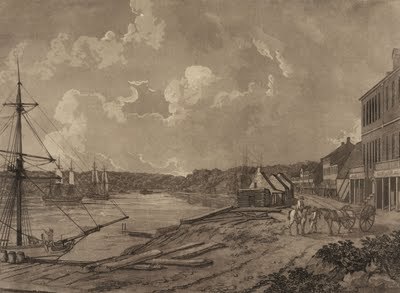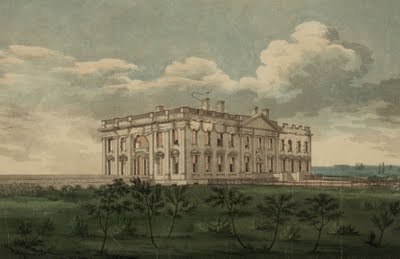Dumbarton House, a Georgetown gem
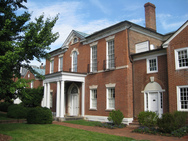
Photo by the author.
The Heights of Georgetown, along Q Street and above, are filled with the elegant homes of well-to-do Washingtonians. Most are still in private hands, but several beautiful public museums stand out.
Dumbarton Oaks, owned by Harvard University and famous for its gardens and art collections, is a sprawling research and museum complex with a Federal-style house embedded in its core. Tudor Place, a grand residence designed by Dr. William Thornton (1759-1828), today illustrates the history of Georgetown and Washington through the lives of its many residents.
Dumbarton House, at 2715 Q Street, NW (and not connected with Dumbarton Oaks in any way) is perhaps less well-known than Dumbarton Oaks and Tudor Place, but it is probably the best at showing what life was like around 1800, when all three were originally constructed.
In those days, Washington City was largely a field of dreams. The Capitol and President’s Mansion were under construction, and a scattering of other buildings, none very remarkable, demonstrated the desire that a town grow here.
Georgetown, at the time a separate entity in the District of Columbia, was better established. It had been established in 1747 as a tobacco inspection site, being located at the highest navigable spot on the Potomac River. Maryland farmers, who grew highly-prized “sweet-scented” tobacco, rolled great hogsheads of it down to the wharf at Georgetown to be exported to Scotland.
By the beginning of the 19th century, the high ridge above the port of Georgetown became the site for a number of “great houses,” removed as it was from the hurly-burly waterfront and offering commanding views of the river and the new city emerging just to the east.
The land had originally been part of a 795-acre patent obtained in 1703 by Col. Ninian Beall (1625-1717). Beall called his property “Rock of Dumbarton” after a famous site in his homeland of Scotland, and the Dumbarton name survives today in many area place names.
Dumbarton House was constructed on this ridge in about 1799 by Samuel Jackson (1755-1836), a Philadelphia merchant and land speculator who lived in the new mansion with his family for about two years. One of his daughters may have been born in the house.
It’s not clear why he built such an elegant house and then left it as soon as he did, but, as David White points out, Jackson was a creature of his times. He was involved in complex business deals involving extensive land holdings in Tennessee, where he eventually settled his family. Jackson would gain passing notoriety in 1807 when he was wounded by President-to-be Andrew Jackson (no relation), who stabbed him with a sword-cane, perhaps over a dispute about a horse race.
The house Jackson built is one of the best examples of the emerging Federal style in architecture in the District. The Federal style often brings to mind plain brick townhouses, two or three stories tall, with gabled roofs; Washington once had blocks and blocks of them.
This is one of a much smaller number of Federal great-houses, laid out in careful Palladian symmetry with wings on each side of a stately central block. At first glance, the building might seem little different from the brick Georgian mansions of the 18th century, but it was actually markedly new and stylish in 1800. The Flemish-bond brick walls no longer seem as heavy and squat as on many Georgian mansions (the James River plantations in Virginia come to mind), and the interior is no longer dim.
When you enter Dumbarton House you are welcomed with bright light from a large Palladian window gracing the stairway landing at the rear of the central passage. Upstairs, the south-facing front windows rise dramatically from the floor, flooding the front rooms with light. No longer content with boxy spaces, Dumbarton House’s designer added a pair of great rounded bow walls to the rear of the house, extending the back rooms with gracious, curved spaces.
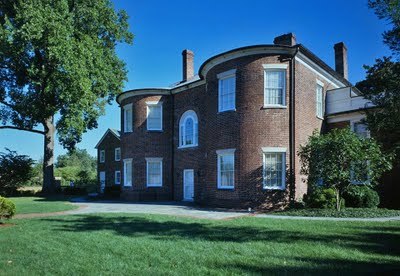
The rear of Dumbarton House, circa 1998. Photo from Historic American Buildings Survey, via Library of Congress.
The first residents after the Jacksons left were Joseph Nourse (1754-1841) and his wife Maria (1765-1850), who moved in in 1804 and purchased the house shortly thereafter for $7,500. The National Society of The Colonial Dames of America (NSCDA), which owns Dumbarton House, has chosen to focus on the Nourse residency for the historic museum portion of the structure and has a long-term project underway to restore the first floor of the house as closely as possible to its appearance when the Nourses lived there.
The son of a successful merchant, Joseph Nourse was a skilled bookkeeper. When serving as a military secretary for General Charles Lee during the Revolution, he was noticed by George Washington. After independence, he was chosen the first Register of the Treasury and kept that position until the Jackson administration. Much of the early Continental currency issued by the new government bears Nourse’s signature.
Nourse was an unassuming individual, a family man with a curious intellect. His Georgetown property eventually included 8 acres of land, enough for a modest subsistence farm where wheat, rye, and hay were grown. Outbuildings included a carriage house, stables, barn, icehouse, and dairy. To keep all this running, the Nourses kept about 10 servants at any given time, some free and some enslaved.
The wheat and rye produced on the estate could be easily carried a short distance down the hill to Rock Creek, where it could be ground into flour at Lyons’ Mill. Joseph likely spent little time overseeing these activities, however. In addition to being “America’s first civil servant,” as he was dubbed in an exhibition in the 1990s, Nourse could just as aptly be considered Washington’s first suburban commuter, traveling daily from his house on Cedar Hill, as it was then called, to his Treasury Department office on Pennsylvania Avenue in Washington City.
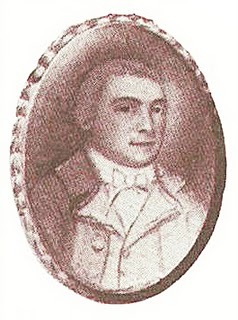
Joseph Nourse as a young man. Image courtesy of Dumbarton House.
In 1813, the Nourses sold the house, and within a few years they moved to the current site of the National Cathedral on upper Wisconsin Avenue. The Nourses’ son, Charles, built his mansion, The Highlands, just north of that, and it now serves as the administration building of the Sidwell Friends School.
The Georgetown house was sold to Charles Carroll (1767-1823), a prominent landowner from the powerful Carroll family of Maryland, which included one of the signers of the Declaration of Independence. Carroll, who was one of the owners of a paper mill on Rock Creek and also had extensive real estate investments in New York, called the property Belle Vue.
Being friends with President James Madison (1751-1836) and Dolley Madison (1768-1849), Carroll played a key role in aiding the Madisons when the British attacked and burned Washington in 1814. After the Battle of Bladensburg went badly for the Americans on the morning of August 24, President Madison knew the British were going to occupy the city, and he asked Carroll to assist Dolley in escaping.
As to what happened next, Dolley later gave biographers the following description, which she said was from a letter she wrote to her sister that day:
Three O’clock. Will you believe it, my Sister? We have had a battle or skirmish near Bladensburg, and I am still here within sound of the cannon! Mr. Madison comes not; may God protect him! Two messengers covered with dust, come to bid me fly; but I wait for him…. Our kind friend, Mr. Carroll, has come to hasten my departure, and is in a very bad humor with me because I insist on waiting until the large picture of Gen. Washington is secured, and it requires to be unscrewed from the wall…. It is done…. And now, dear sister, I must leave this house, or the retreating army will make me a prisoner in it, by filling up the road I am directed to take. When I shall again write you, or where I shall be tomorrow, I cannot tell!!
Carroll safely spirited Dolley to Belle Vue, where she stopped briefly on her way to sanctuary in Virginia. If she were still at Belle Vue that evening, she could have seen the fires in the distance from the Capitol, White House, and Navy Yard burning.
Carroll lived at Belle Vue only a few years before moving to New York, after which he rented the house out. One of his first tenants, beginning in 1815, was Commodore John Rodgers (1773-1838) a naval hero who had been honored by the citizens of Baltimore for helping defend their city from the British in 1814. His daughter Elizabeth was likely the second child born at the Georgetown house.
Rodgers eventually built his own mansion on Lafayette Square, the same house where Secretary of State William H. Seward (1801-1872) was attacked in April 1865 as part of the conspiracy to kill Abraham Lincoln, Vice President Johnson, and Seward.
The property was leased for many years to Samuel Whitall, a New Jersey Quaker, and his family. Whitall’s son bought the house from Carroll’s heirs, passing it to his sister Sarah (1824-1892), who married banker Charles E. Rittenhouse (1814-1880) in 1855.
In the Civil War years and afterwards, the house was known as Rittenhouse Place. Though the house itself seems to have changed very little, Georgetown changed all around it.
The war brought many unruly (and largely unwelcome) Union soldiers who seemed to have little respect for local residents, many of whom sympathized with the South. Troops camped at the Lyons Mill complex on Rock Creek, for example, would occasionally take potshots at the stained glass windows of the chapel in Oak Hill Cemetery, just to the north of Rittenhouse Place. To the south was an encampment of former slaves who had fled across the Potomac from the plantations of Virginia.
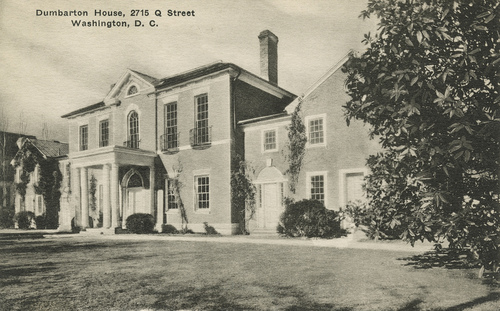
Postcard view of Dumbarton House, circa 1940s (author’s collection).
Meanwhile, lower Georgetown, along the waterfront, had become a rather seedy industrial zone. Massive amounts of silt had filled the harbor, making it nearly useless as a shipping port. Once seafaring trade had diminished, business activity shifted to the assorted mills and factories lining the Chesapeake & Ohio Canal. It was a place for gentlefolk to avoid.
After Sarah Rittenhouse died, the old house on the ridge was sold to Howard Hinckley, who around 1900 made a number of renovations, such as adding decorative Georgian-style “quoins” on the exterior corners of the house and removing an interior wall on the first floor to create a large entertainment room.
Hinckley sold the property in 1912 to John L. Newbold (1871-1931), a prominent local businessman and founder of the Merchants Transfer & Storage Company. Newbold made the purchase knowing that he was acquiring a house with a serious problem; it stood directly in the path of a planned extension of Q Street.
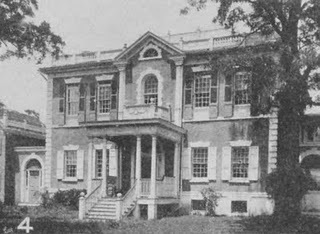
Dumbarton House in 1913, before it was moved. Note there.are steps up to the front entrance (author’s collection)
The Q Street extension was part of a scheme to link the Heights of Georgetown with the well-to-do Sheridan Circle neighborhood via an elegant new bridge (which would become known as the Dumbarton Bridge) spanning the valley of Rock Creek.
Wealthy Washingtonians had been building extravagant mansions along Massachusetts Avenue for several decades, turning the neighborhood into a posh enclave. Isolated on the other side of Rock Creek were the homes of the wealthy Georgetowners, who didn’t have a convenient option for crossing over to the main city.
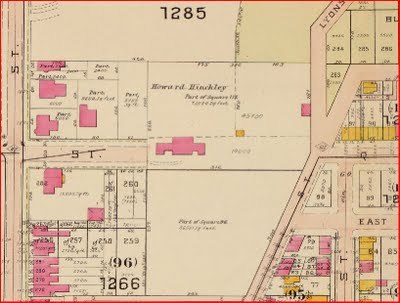
Excerpt form a 1903 Baist insurance map, showing Dumbarton House blocking the route of Q Street across the center of the view.
To extend Q Street, the District planned to tear down Newbold’s mansion, but he got a court order holding them off until he could get it moved. Newbold hired Washington architect Thomas J.D. Fuller (1870-1946) to plan the move and “restoration” of the house, which included dismantling the two wings and then reconstructing them at the house’s new location.
The move of the main house was undertaken by Caleb L. Saers, a Civil War veteran who had run a business of raising and moving houses in the Washington area since at least the 1880s. He found the Newbold mansion particularly challenging. It took three weeks and 200 jacks to raise the old house a half-inch off the ground and probably several months after that to drag it into its new resting place, a spot that had been dug out of the hillside some 60 feet to the north. Regretfully, no pictures have been located that show how this complicated engineering feat was accomplished.
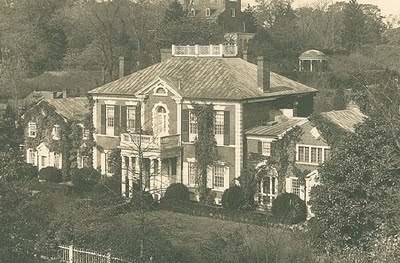
Dumbarton House as it appeared before being restored. Photo courtesy of Dumbarton House.
The mansion’s modern-day history began in 1928, when the NSCDA bought it to serve as their National Headquarters and gave it the name “Dumbarton House.” This time, a thorough and historically-sensitive restoration was undertaken under the leadership of two distinguished architects, Fiske Kimball (1888-1955) of Philadelphia, who had spearheaded the restoration of Thomas Jefferson’s Monticello, and local architect Horace Peaslee (1884-1959), the primary designer of Meridian Hill Park.
Various alterations, mostly done by Hinckley, were reversed, bringing the house back to something close to its original appearance. Many fine details, such as the decorative plaster cornice in the main parlor and dining room, were restored to their original beauty. Decorated with exceptional early American furnishings, many of them donated by state societies associated with the NSCDA, the restored Dumbarton House was opened as a museum in 1932.
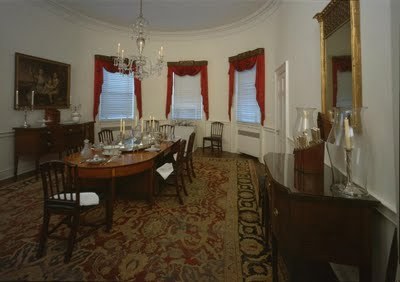
The dining room, as it appeared circa 1998. Photo from Historic American Buildings Survey, via Library of Congress.
Renovations were undertaken again in 1991, modernizing the building’s systems, adding an elevator to enhance accessibility, and increasing office and meeting space apart from the historic core. This unique museum is now open to the public Tuesdays through Sundays, 11 am to 3 pm.
The staff and volunteers at Dumbarton House have done much extensive research into the house’s history, which was very helpful in preparing this post. Frances White and Scott Scholz were particularly helpful in providing advice and correcting factual errors. Additional sources included Deering Davis, Stephen Dorsey, and Ralph Hall, Georgetown Houses of the Federal Period (1944); Harold Eberlein and Cortlandt Hubbard, Historic Houses of George-town & Washington City (1958); Oscar P. Fitzgerald, In Search of Joseph Nourse 1754-1841 (The National Society of The Colonial Dames of America, 1994); Mary Mitchell, Divided Town (1968); Kathryn Schneider Smith, Port Town to Urban Neighborhood: The Georgetown Waterfront of Washington, D.C. 1880-1920 (1989); David D. White, Samuel Jackson: The First Occupant of Dumbarton House (unpublished, 2010); The National Register of Historic Places nomination for Dumbarton House (Dec. 14, 1990); as well as numerous newspaper articles.
Cross-posted at Streets Of Washington

